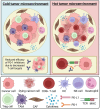Advances and challenges in immunotherapy in head and neck cancer
- PMID: 40547025
- PMCID: PMC12179090
- DOI: 10.3389/fimmu.2025.1596583
Advances and challenges in immunotherapy in head and neck cancer
Abstract
Head and neck squamous cell carcinoma (HNSCC) remains a challenging malignancy with suboptimal survival outcomes despite advances in surgery, radiotherapy, and chemotherapy. Immunotherapy, particularly immune checkpoint inhibitors (ICIs) targeting programmed cell death protein 1 (PD-1)/programmed cell death ligand 1 (PD-L1), has transformed treatment paradigms, yet its full potential in HNSCC is still being explored. This review evaluates the current landscape of immunotherapy in both locally advanced (LA) and recurrent/metastatic (R/M) HNSCC, discussing key clinical trials, emerging biomarkers, and novel therapeutic strategies. For LA HNSCC, phase III trials such as KEYNOTE-412 and JAVELIN Head and Neck 100 failed to demonstrate survival benefits with ICI-chemoradiotherapy combinations in unselected populations, though post hoc analyses suggest efficacy in PD-L1-positive tumors. Recent studies, including KEYNOTE-689 and NIVOPOSTOP GORTEC 2018-01, indicate potential benefits of perioperative ICIs in resectable disease. In R/M HNSCC, ICIs have redefined the standard of care. KEYNOTE-040 and CheckMate 141 led to Food and Drug Administration (FDA) approvals of pembrolizumab and nivolumab, while KEYNOTE-048 established pembrolizumab monotherapy for PD-L1 combined positive score (CPS) ≥1 and pembrolizumab plus chemotherapy as first-line treatment. However, dual checkpoint blockade trials (KESTREL, CheckMate 651) have yielded mixed results, highlighting the complexity of immune resistance. Beyond ICIs, emerging strategies include oncolytic virotherapy, chimeric antigen receptor-T cell therapy (CAR-T), and cancer vaccines, with promising preclinical and early-phase clinical results. Biomarkers such as PD-L1 expression, tumor mutational burden (TMB), and Human Papillomavirus (HPV) status play a critical role in treatment selection, but further validation is needed. Despite advancements, challenges persist, including heterogeneous response rates, immune-related toxicities, and optimal integration of immunotherapy in multimodal treatment regimens. Future research should focus on refining biomarker-driven treatment algorithms, developing rational immunotherapy combinations, and leveraging tumor microenvironment modifications to enhance therapeutic efficacy.
Keywords: chemoradiotherapy; head and neck squamous cell carcinoma; immune checkpoint inhibitors; immunotherapy; locally advanced; radiotherapy; recurrent/metastatic.
Copyright © 2025 Aboaid, Khalid, Hussain, Myat, Nanda, Srinivasmurthy, Nguyen, Jones, Bigcas and Thein.
Conflict of interest statement
KT received honoraria from Targeted Oncology, MD Outlook, Curio Science, Aptitude Health, Inizio, OMNI-Oncology, and Onviv Expert Network and served on the Advisory Board for EMD Serono and on the Speaker Bureau for Eisai, not related to this manuscript. The remaining authors declare that the research was conducted in the absence of any commercial or financial relationships that could be construed as a potential conflict of interest.
Figures





References
-
- Ferlay J, Colombet M, Soerjomataram I, Parkin D, Piñeros M, Znaor A, et al. Global and regional estimates of cancer incidence and mortality in 2020. Int J Cancer. (2021) 149:778–89. doi: 10.1002/ijc.v149.4 - DOI
-
- Seiwert TY, Burtness B, Mehra R, Weiss J, Berger R, Eder JP, et al. Safety and clinical activity of pembrolizumab for treatment of recurrent or metastatic squamous cell carcinoma of the head and neck (KEYNOTE-012): an open-label, multicentre, phase 1b trial. Lancet Oncol. (2016) 17:956–65. doi: 10.1016/S1470-2045(16)30066-3 - DOI - PubMed
-
- Cohen EEW, Soulières D, Le Tourneau C, Dinis J, Licitra L, Ahn MJ, et al. Pembrolizumab versus standard-of-care chemotherapy for recurrent or metastatic head and neck squamous cell carcinoma (KEYNOTE-040): a randomised, open-label, phase 3 study. Lancet. (2019) 393:156–67. doi: 10.1016/S0140-6736(18)31999-8 - DOI - PubMed
Publication types
MeSH terms
Substances
LinkOut - more resources
Full Text Sources
Medical
Research Materials

